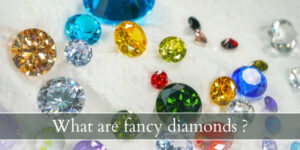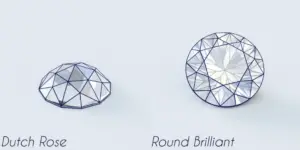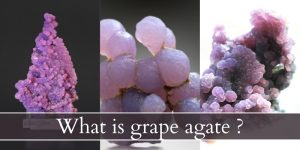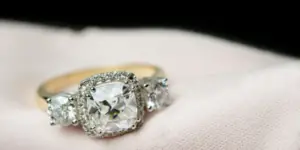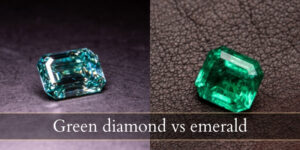In the world of gemstones inclusions are both prized and shunned, depending on what gem we’re talking about. Today’s gem is rutilated quartz, and it’s the inclusions within rutilated quartz that give it its signature look and appeal to the collectors.
Let’s discuss what rutilated quartz is, how it gets those amazing inclusions, and just how wearable this statement-piece gemstone really is.
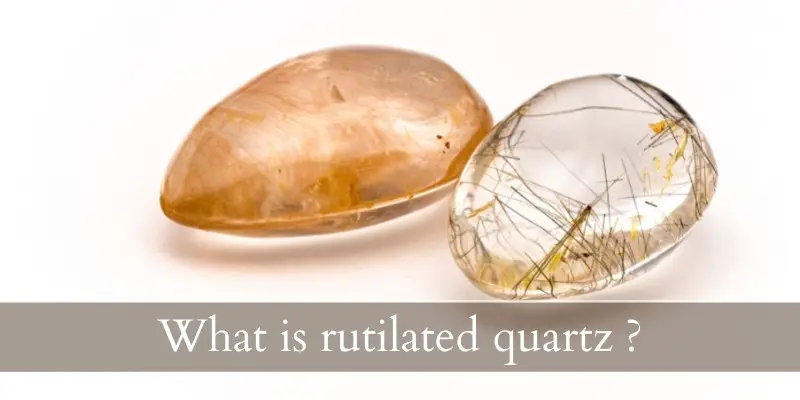
What is rutilated quartz ?
Rutilated quartz is a variety of clear quartz with needle-like rutile inclusions that run across the crystal, sometimes in intersecting lines and sometimes parallel to each other. The inclusion colors are usually gold, copper, silvery-grey, brown, or black. A high density of inclusions can make the quartz crystal look almost opaque, though these specimens are rare and fetch a very high price.
Rutilated quartz comes in different colors and intensities, and you might find it in very surprising places. For example Cartier’s high jewelry Soreli watch features a stunning golden rutilated quartz cabochon that completely steals the show. Another example is Anna Sheffield rutilated quartz jewelry line, which features a lot of black rutile quartz, with a few gold rutile pieces here and there.
A quick Google search for ‘rutilated quartz jewelry’ will yield am impressive array of options, with this gem set among diamond, 18k gold, and garnets ! So despite rutilated quartz being quartz – an inexpensive gem at heart – these inclusions and their overall effect elevate it to a much higher status.
Is rutilated quartz real gold ?
Rutilated quartz is not real gold, as the inclusions within it are made of the mineral rutile, which is actually titanium dioxide. The reason rutile quartz often appears golden is because that is the usual color titanium dioxide appears in quartz when found in very thin growths. Darker inclusions (like red, brown, or black) are usually thicker.
So despite rutilated quartz appearing golden, it does not contain any gold at all. It still is very beautiful to look at, especially if you find a cabochon that also features an effect very similar to a cat’s eye, with all the needles aligned parallel to each other and packed very densely.
Read also: What Color Is Alexandrite ?
Is rutilated quartz rare ?
Rutilated quartz is not rare in nature, as it’s simply quartz with inclusions, which is very common. A high number of inclusions that form a pleasing pattern and are also fairly dense is a bit rarer indeed, but these specimens can still be found by any jeweler is you ask for them.
Rutilated quartz has been relegated to more obscure or niche jewelry, as perfectly clear gems with zero inclusions have always been the most sought after. This means you have a higher chance of finding rutilated quartz jewelry in one of two places:
- handmade jewelry, such as Etsy markets and the like
- some designer jewelry which may feature some rutilated quartz for dramatic effect
Or, you can simply source rutilated quartz from various online shops and set the gem in your very own design.
Is rutilated quartz expensive ?
Rutilated quartz is not expensive at all, because quartz is a very common mineral that can easily be sourced from many places. This includes rutile quartz. You can find rutile quartz at prices ranging from $5-20 per carat, depending on the density and pattern of the rutile inclusions. While rutilated quartz is inexpensive, it is a very sought-after collector’s item if it has a very pleasing pattern, and some specimens may get a bit expensive.
Can you wear rutilated quartz every day ?
Rutilated quartz has a Mohs rating of 7 out of 10, which deems it fit for everyday wear. However it may scratch or chip if not treated with care, especially if you wear it while doing a lot of manual labor or work in a way that constantly exposes the quartz to wear and tear.
We recommend rutilated quartz to be set in pendants or earrings, as these are generally safer options. A ring with a rutilated quartz center stone has a small chance of scratching in time or chipping too much. Then again, rutilated quartz is fairly affordable, so a replacement would not cost much but finding the exact same pattern in another quartz would be difficult.
Read also: Why Is Gold So Valuable ?
Rutilated quartz alternatives
If you’d like to look at other options that are similar to rutilated quartz, there are a few you can consider. We’ve compiled this list of alternative gems keeping in mind the idea of linear inclusions, a mostly golden appearance, and just an overall impressive look about the gem.
Tiger’s eye quartz
Another type of quartz, tiger’s eye is also called cat’s eye by some. It has an an amazing shift dark brown (nearly black) to honey-gold in a narrow band. This effect is due to an interspersed growth of clear quartz crystals and limonite. This patters results in densely-packed layers that offer a very fine silky lustre, when viewed at the correct angle. You can find these gems cut into cabochons, or spheres to be used as beads.
Cat’s eye Oregon sunstone
The Oregon sunstone is like a cross between tiger’s eye and rutilated quartz. Its overall color is much lighter, ranging from amber to deep golden, and its needle-like parallel layers are not as fine as tiger’s eye, but finer than rutilated quartz.
Oregon sunstone is a type of feldspar, ranging at 6-6.5 Mohs scale so if you intend to wear it be mindful of the setting, it should be a protective setting – like bezel – or set in something that will not move a lot, like earrings or pendants.
Rainbow lattice sunstone
This is possibly the most impressive gem on this list. It’s a somewhat clear gemstone (body) with an impressive criss-cross pattern that shows a whole lot of iridescence. The overall body also shows some aventurescence, which is an effect similar to tiny glitter particles.
This sunstone is a type of orthoclase feldspar, and it owes its colorful inclusions to hematite and magnetite, which arrange themselves into this plates along a single plane but in different directions, forming the lattice effect.

I’m the main author for jewelrymaterialguide.com. I started this site after we did tons of research before our wedding and noticed that there is information about rings, jewelry, and so on that is really hard to find on the internet.

